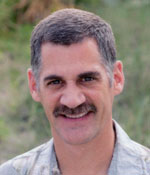
While stationed in Okinawa, Japan, flying the F-15 I made periodic trips to the Philippines to fly in Cope Thunder exercises—the Pacific version of Red Flag. They would schedule up to 70 aircraft in a very dynamic war training event with airplanes split Blue Air against Red Air.

On one mission we had about 40 fighter aircraft assigned to Blue Air, mostly flying as four-ship formations with a few two-ship formations in the mix. For departure and join up, each flight had an assigned taxi and takeoff time that put the whole group into a long string. We would all fly about 80 miles to the north, and then head west about 30 miles to put us over the South China Sea before we headed south and southeast in different groups to make our sweeps and attacks at the range located near the base. I was still an inexperienced pilot at the time and was assigned to fly on someone else’s wing. Even though I wouldn’t be leading anything that day, I took careful notes in the briefing as to each flight’s position in the departure gaggle.
I am glad I did. I had a maintenance issue that forced me to a spare jet before taxiing. The air boss gave me permission to taxi after the other 39 fighters, and 12 of the Red Air fighters, had taken off. I was on my own to find my flight and rejoin. I did an afterburner climb to Flight Level 410 to take advantage of a higher true airspeed at high altitude and while heading generally northwest I found the gaggle on radar on its westbound leg. Each four-ship was spread apart by about a half mile laterally with about a mile spacing between each flight in the string. At long range, my radar just showed a bunch of blobs.
With the group eventually heading south and me heading north, there was very little room for error for me to make my rejoin turn. If I turned too early I would end up in front of my flight, and slowing down to “back up” into formation would not be safe with other fighters in between. If I turned too late I would use up all my gas to run them down from behind. Referencing my notes, and now seeing individual blips on the radar, I first found my flight on radar and then found the tiny specks visually. Intently clearing my flight path the entire way, and asking for lead to give me a quick wing rock to confirm I was joining on the correct flight, I completed the rejoin. I then realized how fast my heart was racing. The rest of that mission, the really fun stuff, was just icing on the cake for a great feeling of accomplishment that day.
Sun ’n Fun Fly-In & Expo in Lakeland, Fla., is just around the corner (April 9 through 14) with EAA AirVenture in Oshkosh, Wis., not far behind (July 29 through Aug. 4). If you haven’t done one of those fly-ins yet, maybe this can be your year. If you aren’t ready to fly in yourself, find a copilot/navigator to help with the duties (and fuel costs). Veterans of these fly-ins can offer a seat to teach others. In all cases, a good self-briefing with careful note-taking of the fly-in procedures and a disciplined visual lookout will help make it a memorable experience for you.
Then stop by the AOPA tent and let the team know you made the trip!
Larry Brown of Colorado Springs, Colo., is a retired Air Force F-15 pilot who is using the lessons he learned as a fighter pilot as a GA pilot in his Cessna P210. Brown, who has 2,700 hours total time during his 33 years of flying, also was an instructor pilot and flight examiner in the Air Force T-38 and instructor pilot in the T-52, the military’s version of GA’s Diamond DA40. See previous installments of “Fly like a fighter.”



